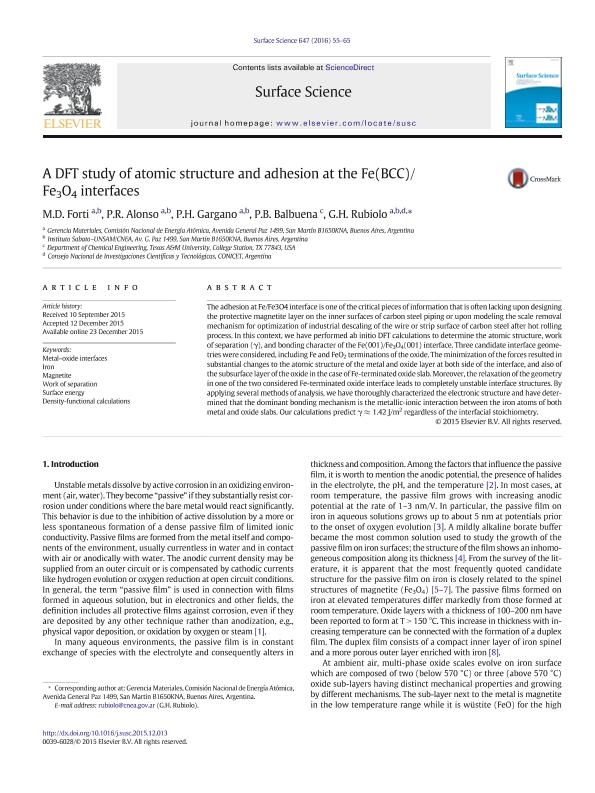Artículo
A DFT study of atomic structure and adhesion at the Fe(BCC)/Fe 3 O 4 interfaces
Forti, M. D.; Alonso, Paula Regina; Gargano, Pablo Hugo; Balbuena, Perla Beatriz; Rubiolo, Gerardo Hector

Fecha de publicación:
05/2016
Editorial:
Elsevier Science
Revista:
Surface Science
ISSN:
0039-6028
Idioma:
Inglés
Tipo de recurso:
Artículo publicado
Clasificación temática:
Resumen
The adhesion at Fe/Fe3O4 interface is one of the critical pieces of information that is often lacking upon designing the protective magnetite layer on the inner surfaces of carbon steel piping or upon modeling the scale removal mechanism for optimization of industrial descaling of the wire or strip surface of carbon steel after hot rolling process. In this context, we have performed ab initio DFT calculations to determine the atomic structure, work of separation (γ), and bonding character of the Fe(001)/Fe<sub>3</sub>O<sub>4</sub>(001) interface. Three candidate interface geometries were considered, including Fe and FeO<sub>2</sub> terminations of the oxide. The minimization of the forces resulted in substantial changes to the atomic structure of the metal and oxide layer at both side of the interface, and also of the subsurface layer of the oxide in the case of Fe-terminated oxide slab. Moreover, the relaxation of the geometry in one of the two considered Fe-terminated oxide interface leads to completely unstable interface structures. By applying several methods of analysis, we have thoroughly characterized the electronic structure and have determined that the dominant bonding mechanism is the metallic-ionic interaction between the iron atoms of both metal and oxide slabs. Our calculations predict γ ≈ 1.42 J/m<sup>2</sup> regardless of the interfacial stoichiometry.
Archivos asociados
Licencia
Identificadores
Colecciones
Articulos(SEDE CENTRAL)
Articulos de SEDE CENTRAL
Articulos de SEDE CENTRAL
Citación
Forti, M. D.; Alonso, Paula Regina; Gargano, Pablo Hugo; Balbuena, Perla Beatriz; Rubiolo, Gerardo Hector; A DFT study of atomic structure and adhesion at the Fe(BCC)/Fe 3 O 4 interfaces; Elsevier Science; Surface Science; 647; 5-2016; 55-65
Compartir
Altmétricas



